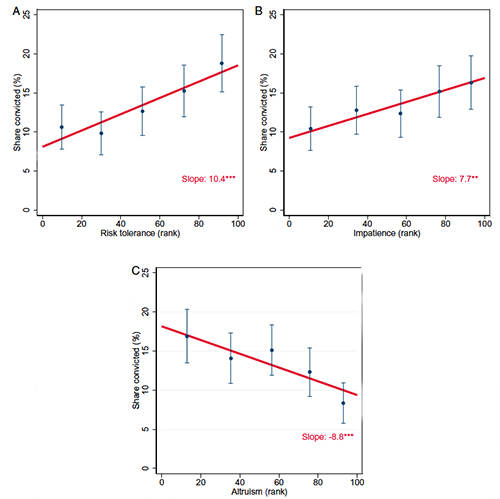The study began with 18 and 19-year-old Danish men invited to participate in an online survey. Of the roughly 14,000 invitations, 39% of them accepted and completed the survey. The participants were offered 16 “choice situations,” receiving approximately $40 US for their efforts.
Choices were designed to elicit time preferences, or their degree of impatience. For example, they could receive an immediate monetary reward, or wait several weeks and receive the reward and accrued interest. The mean savings was scaled as the degree of impatience.
Other choices were designed to assess risk preference. In these scenarios, an individual could accept an immediate certain payment, or place some or all the money into a lottery with a rate of return of 6%, but “with the risk of significant loss.” Again, the money was scaled as a degree of risk aversion. Finally, because a life of crime may be mitigated by altruism, or a concern for the victims, the third series of questions sought to determine an individual’s altruistic feelings.
This experimental data was linked to a database of criminal activity for these individuals from age 15 to 20, with traffic violations excluded. Nineteen percent of the male respondents had a criminal record in the initial analysis, while only 3% of the female participants did. Following Sutton’s Law [1], the researchers looked at the results for the males. Here are the results:
 No real surprises. As individuals became more impatient and less risk-averse they committed more crimes. For every 10% increase in risk tolerance, criminal behavior rose by 1%. And for a similar 10% rise in impatience there was an 0.8% increase. Altruism lowered criminality by 0.9% for each 10% more altruism. The researchers also considered self-control of a fellow traveler with impatience; cognitive ability as measured by GPA. They considered several other socio-demographic factors. But interestingly enough, GPA ranking at the end of compulsory education in Denmark (which occurs at age 15-16) was the strongest predictor of criminal activity. It was three-fold stronger than impatience, and twice as strong as the effect of comfort with risk.
No real surprises. As individuals became more impatient and less risk-averse they committed more crimes. For every 10% increase in risk tolerance, criminal behavior rose by 1%. And for a similar 10% rise in impatience there was an 0.8% increase. Altruism lowered criminality by 0.9% for each 10% more altruism. The researchers also considered self-control of a fellow traveler with impatience; cognitive ability as measured by GPA. They considered several other socio-demographic factors. But interestingly enough, GPA ranking at the end of compulsory education in Denmark (which occurs at age 15-16) was the strongest predictor of criminal activity. It was three-fold stronger than impatience, and twice as strong as the effect of comfort with risk.
There was one additional finding that I thought was worth writing about. Clearly, an ability to be comfortable with risk – let's call it "risk-avidity" for lack of a better term – is part of all criminal behavior. But when the researchers looked at property offenses, impatience was a significant predictor. Self-control was more critical when considering violent, drug, and sexual crimes. The researchers suggest that the choice of crime may hinge on the balance of impatience and self-control.
“We also find that variation in preferences significantly predicts property offenses but not crimes of passion such as violent, sexual, and drug offenses. Conversely, we find that self-control significantly predicts crimes of passion but not property crime.”
Today in New York, there is an increasingly vocal debate over bail reform. For misdemeanors and non-violent felonies, cash bail is banned as a condition of release. Cash bail and detention are two of several options for violent crimes and sexual offenses. Amendment to the law now allows for cash bail after assault, even if vehicular and for burglary when a home is “invaded."
It is an intriguing idea to collect more data on these criminals’ preferences. Maybe their degree of altruism and self-control are better metrics for restricting their pre-trial activities than a litany of different criminal acts. It would be an interesting study that could well inform the discussion.
###
[1] Willie Sutton, a notorious bank robber of the 1930s, was asked why he robbed banks and replied, “That’s where the money is.”
Source: Preferences predict who commits crime among young men PNAS DOI:10.1073/pnas.2112645119




